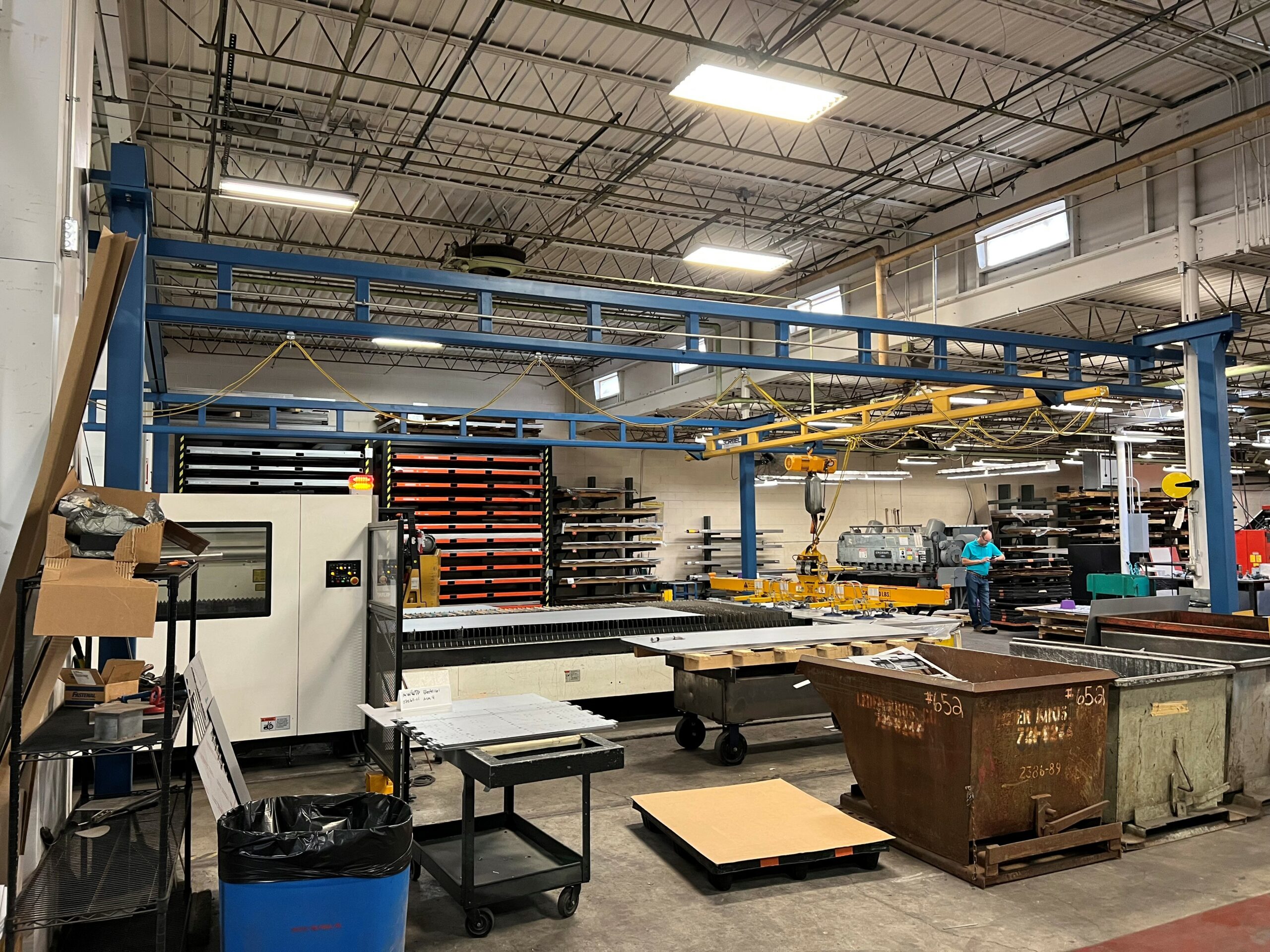Crane Types
Whether you are in need of a simple jib crane or a complete overhead crane system, Midwest Overhead Crane has the solution for you. We offer building supported, free standing, pre-fabricated, and even fully customer-designed crane systems.

Top Running Crane
A top running crane rides on a fixed rail system which is installed on top of each of the system’s runway beams. Top running cranes come in either a single girder design or a double girder design. Single girder cranes utilize an underhung trolley and hoist while a double girder crane utilizes a top riding hoist and trolley. Top running cranes are extremely versatile and can be designed for a wide variety of capacities and typically can accommodate wider spans when higher capacities are required.

Under Running Crane
An under-running crane, or commonly referred to as an “under-hung” crane uses wheels that are supported by the bottom flange of the runway beam to move the bridge up and down the runway. Under-hung cranes are most commonly configured in a single girder design for lighter service and lower-capacity applications. They can also be built in a double girder design for higher capacities or more hook height where needed.
Typically tied into the building structure itself, under-hung bridge cranes don’t require column support structures if the building structure can support the crane. Without the need for support columns, this type of configuration allows for more crane service area coverage. The work area below the crane is completely unobstructed by columns which is advantageous in facilities with limited floor space or complex processes. This comes at the cost of hook height. Under-hung crane configurations typically have a reduction in the distance of the hook to the floor. Overall, your priorities in crane configuration are determined by your lifting needs and the building itself.

Gantry Crane
Gantry cranes offer a more flexible and versatile option than a fixed, permanent bridge cranes. They are completely self-sufficient and are supported by their own A frames. Gantry cranes are usually on wheels or mounted onto a track system. They are far easier and quicker to assemble than bridge cranes and can be easily moved outside and inside and from site to site where required.
For applications where flexibility and mobility are required, gantry cranes are a great option. Gantry cranes have excellent lifting capacities and can be used in a wide range of scenarios including confined space access and fall protection. They can be combined with a range of lifts, hoists, and winches, and can be used for lifting materials, machinery, equipment, and personnel.
An added advantage to gantry cranes is that they are often on casters to create a mobile lifting device which allows for a more cost-effective solution which can service across an entire work site in a range of applications.

Jib Crane
Jib cranes provide a good solution for material handling support in lieu of overhead bridge cranes. They can be sized to cover most light duty assembly and machining operations. Typical capacities range from small tool solution jib cranes of 150 lbs up to 10 ton capacity jibs using I-Beam construction. Collector rings can be added to allow for 360° rotation on free standing jibs depending on the application.
Foundations are required for jibs of higher capacity and longer reach/span. However, free standing work station jib cranes can be sized efficiently to bolt directly to your existing floor without the need of foundations. This is often achieved at capacities of 1,000lbs or less. These workstation jibs have an enclosed track design which allows for easier trolley movement and are great for use with vacuum lifters, tool balancers, and small hoists.
If you cannot spare the floor space we also offer wall mounted and tie rod jib cranes. We can recommend which best suits your application best depending on headroom and capacity requirements.

Light Duty Crane
For those customers looking for overhead crane coverage in a small area of their facility, workstation cranes are the perfect fit. With capacities up to 2 tons, they are an excellent means of increasing assembly capabilities. Their enclosed track construction provides easy movement for improved workplace ergonomics.
Most freestanding systems can be easily installed on a 6″ concrete floor, giving them countless possibilities as to where they can be utilized throughout your facility. If you want to maximize the capacity of one of these systems and take it up to 2 tons, there are tractor drive options available to motorize trolley and end truck motion.
If floor space comes at a premium in your shop there are also ceiling suspended versions available with all the same specifications.
Build the Best Euipment for Your Application
At Midwest Overhead Crane we can take a new crane project from start to finish. Whether a box girder, a jib crane or anything in between, our experienced and professional sales team will help you design a crane that meets your needs and CMAA design standards. We will work with our network of vendors to supply top of the line components, fabricate, and factory test the crane at one of our facilities. Once we have it built by our in-house fabrication crew, we utilize our own personnel for field installation. Our crews are highly qualified and trained for this specialty type of work.

